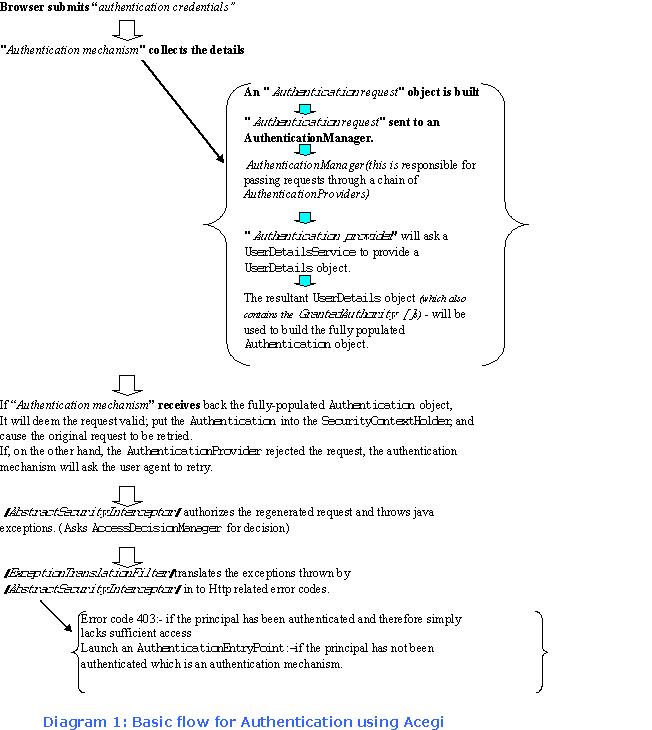Software:Spring Security
| Developer(s) | 4 |
|---|---|
| Stable release | 5.2.1
/ November 4, 2019 [1] |
| Written in | Java |
| Operating system | Cross-platform |
| Type | web application framework security |
| License | Apache License 2.0 |
| Website | projects |
Spring Security is a Java/Java EE framework that provides authentication, authorization and other security features for enterprise applications. The project was started in late 2003 as 'Acegi Security' (pronounced Ah-see-gee /ɑːsiːdʒiː/, whose letters are the first, third, fifth, seventh, and ninth characters from the English alphabet, in order to prevent name conflicts[2]) by Ben Alex, with it being publicly released under the Apache License in March 2004. Subsequently, Acegi was incorporated into the Spring portfolio as Spring Security, an official Spring sub-project. The first public release under the new name was Spring Security 2.0.0 in April 2008, with commercial support and training available from SpringSource.
Authentication flow
Diagram 1 shows the basic flow of an authentication request using the Spring Security system. It shows the different filters and how they interact from the initial browser request, to either a successful authentication or an HTTP 403 error.
| Browser submits "authentication credentials" | |
| "Authentication mechanism" collects the details | |
| An "authentication request" object is built | |
| Authentication request sent to an AuthenticationManager | |
| AuthenticationManager (this is responsible for passing requests through a chain of AuthenticationProviders) | |
"Authentication provider" will ask a UserDetailsService to provide a UserDetails object
| |
The resultant UserDetails object (which also contains the GrantedAuthority[]s) will be used to build the fully populated Authentication object.
| |
If "Authentication mechanism" receives back the fully populated Authentication object, it will deem the request valid, put the Authentication into the SecurityContextHolder; and cause the original request to be retried.If, on the other hand, the AuthenticationProvider rejected the request, the authentication mechanism will ask the user agent to retry.
| |
AbstractSecurityInterceptor authorizes the regenerated request and throws Java exceptions. (Asks AccessDecisionManager for decision.)
| |
ExceptionTranslationFilter translates the exceptions thrown by AbstractSecurityInterceptor into HTTP related error codes
| |
| Error code 403 – if the principal has been authenticated and therefore simply lacks sufficient access Launch an AuthenticationEntryPoint – if the principal has not been authenticated which is an authentication mechanism
| |
Key authentication features
- LDAP (using both bind-based and password comparison strategies) for centralization of authentication information.[3]:{{{1}}}
- Single sign-on capabilities using the popular Central Authentication Service.
- Java Authentication and Authorization Service (JAAS) LoginModule, a standards-based method for authentication used within Java. Note this feature is only a delegation to a JAAS Loginmodule.
- Basic access authentication as defined through RFC 1945.
- Digest access authentication[3]:{{{1}}} as defined through RFC 2617 and RFC 2069.
- X.509 client certificate presentation over the Secure Sockets Layer standard.
- CA, Inc SiteMinder for authentication (a popular commercial access management product).
- Su (Unix)-like support for switching principal identity over a HTTP or HTTPS connection.
- Run-as replacement, which enables an operation to assume a different security identity.
- Anonymous authentication, which means that even unauthenticated principals are allocated a security identity.
- Container adapter (custom realm) support for Apache Tomcat, Resin, JBoss and Jetty (web server).
- Windows NTLM to enable browser integration (experimental).
- Web form authentication, similar to the servlet container specification.
- "Remember-me" support via HTTP cookies.
- Concurrent session support, which limits the number of simultaneous logins permitted by a principal.
- Full support for customization and plugging in custom authentication implementations.
Key authorization features
- AspectJ method invocation authorization.
- HTTP authorization of web request URLs using a choice of Apache Ant paths or regular expressions.
Instance-based security features
- Used for specifying access control lists applicable to domain objects.
- Spring Security offers a repository for storing, retrieving, and modifying ACLs in a database.[3]:{{{1}}}
- Authorization features are provided to enforce policies before and after method invocations.
Other features
- Software localization so user interface messages can be in any language.
- Channel security, to automatically switch between HTTP and HTTPS upon meeting particular rules.
- Caching in all database-touching areas of the framework.
- Publishing of messages to facilitate event-driven programming.
- Support for performing integration testing via JUnit.
- Spring Security itself has comprehensive JUnit isolation tests.
- Several sample applications, detailed JavaDocs and a reference guide.
- Web framework independence.
Releases
- 2.0.0 (April 2008)
- 3.0.0 (December 2009)
- 3.1.0 (December 7, 2011)
- 3.1.2 (August 10, 2012)
- 3.2.0 (December 16, 2013)
- 4.0.0 (March 26, 2015)
- 4.1.3 (August 24, 2016)
- 4.2.0 (November 10, 2016)
- 3.2.10, 4.1.4, 4.2.1 (December 22, 2016)
- 4.2.2 (March 2, 2017)
- 4.2.3 (June 8, 2017)
- 5.0.0 (November 28, 2017)
- 5.0.8, 4.2.8 (September 11, 2018)[4]
- 5.1.0 GA (September 27, 2018)[5]
- 5.1.1, 5.0.9, 4.2.9 (October 16, 2018)[6]
- 5.1.2, 5.0.10, 4.2.10 (November 29, 2018)[7]
- 5.1.3, 5.0.11, 4.2.11 (January 11, 2019)[8]
- 5.1.4 (February 14, 2019)[9]
- 5.1.5, 5.0.12, 4.2.12 (April 3, 2019)[10]
Citations
- ↑ "Spring Security 5.2.1 and 5.1.7 Released". https://spring.io/blog/2019/11/04/spring-security-5-2-1-and-5-1-7-released.
- ↑ "Why the name Acegi?". https://spring.io/blog/2007/01/25/why-the-name-acegi.
- ↑ 3.0 3.1 3.2 Deinum et al. 2014.
- ↑ "Spring Security 5.0.8 and 4.2.8 Released". https://spring.io/blog/2018/09/11/spring-security-5-0-8-and-4-2-8-released.
- ↑ "Spring Security 5.1 goes GA". https://spring.io/blog/2018/09/27/spring-security-5-1-goes-ga.
- ↑ "Spring Security 5.1.1, 5.0.9, and 4.2.9 Released". https://spring.io/blog/2018/10/16/spring-security-5-1-1-5-0-9-and-4-2-9-released.
- ↑ "Spring Security 5.1.2, 5.0.10, 4.2.10 Released". https://spring.io/blog/2018/11/29/spring-security-5-1-2-5-0-10-4-2-10-released.
- ↑ "Spring Security 5.1.3, 5.0.11, 4.2.11 Released". https://spring.io/blog/2019/01/11/spring-security-5-1-3-5-0-11-4-2-11-released.
- ↑ "Spring Security 5.1.4 Released". https://spring.io/blog/2019/02/14/spring-security-5-1-4-released.
- ↑ "Spring Security 5.1.5, 5.0.12, 4.2.12 Released". https://spring.io/blog/2019/04/03/spring-security-5-1-5-5-0-12-4-2-12-released.
References
- Deinum, Marten; Rubio, Daniel; Long, Josh; Mak, Gary (September 1, 2014). Spring Recipes: A Problem-Solution Approach (Second ed.). Apress. p. 1104. ISBN 978-1-4302-2499-0.
- "Why the name Acegi?". https://spring.io/blog/2007/01/25/why-the-name-acegi.
External links
 |


